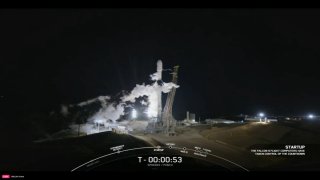
What to Know
- A SpaceX rocket launched Tuesday from Vandenberg Space Force Base in Santa Barbara County.
- The rocket carried the SPHEREx mission space telescope that will collect data on more than 450 million galaxies and 100 million stars.
- The mission might help scientists better understand the origins of the universe, including what happened in the moments after the big bang.
- The Falcon 9 rocket also will usher into space four small satellites to observe the Sun and unlock mysteries about the effects of solar winds.
A mission that could provide a cosmic history lesson launched Tuesday evening from the Southern California coast.
Stream Los Angeles News for free, 24/7, wherever you are.
Originally set to launch Monday, the SpaceX rocket carrying a space telescope and suitcase-sized satellites was re-scheduled to lift off from Vandenberg Space Force Base near Santa Barbara due to unfavorable weather. Tuesday provided more ideal conditions and the rocket was able to take off.
Watch Falcon 9 launch @NASA’s SPHEREx Observatory and PUNCH satellites to orbit from California https://t.co/gWbiHOEoMh
— SpaceX (@SpaceX) March 12, 2025
Get top local stories in Southern California delivered to you every morning with NBC LA's News Headlines newsletter.
The Spectro-Photometer for the History of the Universe, Epoch of Reionization and Ices Explorer mission -- or SPHEREx mission -- is expected to last about two years in an effort to collect data on more than 450 million galaxies and 100 million stars, helping scientists better understand the origins of the universe. The space telescope, considered a cosmic mapmaker, will observe the celestial sky four times in two years to create a 3D map of those the galaxies.
The result could be a cosmic history lesson and better understanding of what a happened a fraction of a second after the big bang.
Local
Get Los Angeles's latest local news on crime, entertainment, weather, schools, cost of living and more. Here's your go-to source for today's LA news.
“It’s going to answer a fundamental question: How did we get here?” Shawn Domagal-Goldman, acting director of the astrophysics division at NASA headquarters, said in a news briefing.
The space observatory's advanced spectrometers will allow researchers to split infrared light from stars and galaxies into different colors -- like sunlight through a prism. Studying that light can reveal information about an object's composition, density, temperature and motion.
The observations could provide answers about how galaxies formed, including the origins of water.
"In splitting up the light, we can use that to determine the distance to galaxies, to build up that three-dimensional map, and we also see the fingerprints of water,” Jamie Bock, principal investigator of the SPHEREx mission and a professor of physics at the California Institute of Technology, told NBC News. "This is a new capability, and with any new capability comes the potential for discoveries and surprises."
The Falcon 9 rocket also will usher into space four Polarimeter to Unify the Corona and Heliosphere (PUNCH) satellites to observe the Sun and unlock mysteries about the effects of solar winds. The small satellites will map the Sun's outer atmosphere, the corona, transition to solar wind and materials constantly being ejected into space.
The Falcon 9's first stage will return to a landing zone at the base.
The rocket and its exhaust plume are sometimes visible for hundreds of miles as it soars along the coast, if skies are clear. Launches just after sunset and before sunrise usually provide the best views as the rocket reflects the sun's rays against the backdrop of a darkened sky.



